A Systematic Literature Review of Reverse Logistics of End-of-Life Vehicles: Bibliometric Analysis and Research Trend
Abstract
:1. Introduction
2. Research Methodologies
2.1. Bibliometrics and Content Analysis
2.2. Tools
2.3. Data Sources and Processing
3. Results and Analysis
3.1. Overview of the Publication Performance
3.1.1. Primary Analysis of Influential Journals
3.1.2. Primary Analysis of Influential Countries/Regions
3.1.3. Primary Analysis of Influential Institution
3.1.4. Primary Analysis of Influential Authors
3.1.5. Analysis of Subject Categories
3.2. Research Themes
3.2.1. The Top 10 Frequently Cited Articles
3.2.2. The Most Frequently Used Keywords
(1) Keywords Co-Occurrence and Categorization
(2) Keywords Citation Bursts
4. Discussion
4.1. Development of Publications
4.2. Future Research Emphasis and Trend
4.2.1. Reverse Logistics Network
4.2.2. Prediction of the Number of ELVs
4.2.3. Life Cycle Assessment and Environment Effect
5. Conclusions
Author Contributions
Funding
Acknowledgments
Conflicts of Interest
References
- Stock, J.R. Reverse Logistics: White Paper; Council of Logistics Management: Oak Brook, IL, USA, 1992; pp. 2–67. [Google Scholar]
- Simic, V. End-of-life vehicle recycling—A review of the state-of-the-art. Tech. Gaz. 2013, 20, 371–380. [Google Scholar]
- Vermeulen, I.; Van Caneghem, J.; Block, C.; Baeyens, J.; Vandecasteele, C. Automotive shredder residue (ASR): Reviewing its production from end-of-life vehicles (ELVs) and its recycling, energy or chemicals’ valorisation. J. Hazard. Mater. 2011, 190, 8–27. [Google Scholar] [CrossRef] [PubMed]
- EuroStat End-of-life Vehicles—Reuse, Recycling and Recovery Totals. EuroStat, 2018. Available online: https://ec.europa.eu/eurostat (accessed on 27 November 2018).
- Zorpas, A.A.; Inglezakis, V.J. Automotive industry challenges in meeting EU 2015 environmental standard. Technol. Soc. 2012, 34, 55–83. [Google Scholar] [CrossRef]
- Alwaeli, M.A.M. End-of-life vehicles recovery and recycling and the route to comply with EU directive targets. Environ. Prot. Eng. 2016, 42, 191–202. [Google Scholar] [CrossRef]
- Environment, E.C.D. End-of-life vehicles: Influence of production costs on recycling rates. Science for Environment Policy-News Alert, 3 May 2012; 282. [Google Scholar]
- Smith, V.M.; Keoleian, G.A.G.U. The Value of Remanufactured Engines: Life-Cycle Environmental and Economic Perspectives. J. Ind. Ecol. 2004, 8, 193–221. [Google Scholar] [CrossRef]
- Chen, D.; Ignatius, J.; Sun, D.; Zhan, S.; Zhou, C.; Marra, M.; Demirbag, M. Reverse logistics pricing strategy for a green supply chain: A view of customers’ environmental awareness. Int. J. Prod. Econ. 2019, 217, 197–210. [Google Scholar] [CrossRef] [Green Version]
- Millet, D.; Yvars, P.; Tonnelier, P. A method for identifying the worst recycling case: Application on a range of vehicles in the automotive sector. Resour. Conserv. Recycl. 2012, 68, 1–13. [Google Scholar] [CrossRef]
- Kuşakcı, A.O.; Ayvaz, B.; Cin, E.; Aydın, N. Optimization of reverse logistics network of End of Life Vehicles under fuzzy supply: A case study for Istanbul Metropolitan Area. J. Clean. Prod. 2019, 215, 1036–1051. [Google Scholar] [CrossRef]
- Sharma, L.; Pandey, S. Recovery of resources from end-of-life passenger cars in the informal sector in India. Sustain. Prod. Consum. 2020, 24, 1–11. [Google Scholar] [CrossRef]
- Karagoz, S.; Aydin, N.; Simic, V. End-of-life vehicle management: A comprehensive review. J. Mater. Cycles Waste 2020, 22, 416–442. [Google Scholar] [CrossRef] [Green Version]
- Rosa, P.; Terzi, S. Waste Electrical and Electronic Equipments versus End of Life Vehicles: A State of the Art Analysis and Quantification of Potential Profits. Procedia CIRP 2016, 48, 502–507. [Google Scholar] [CrossRef] [Green Version]
- Cucchiella, F.; Adamo, I.D.; Rosa, P.; Terzi, S. Scrap automotive electronics: A mini-review of current management practices. Waste Manag. Res. 2015, 34, 3–10. [Google Scholar] [CrossRef]
- Buekens, A.; Zhou, X. Recycling plastics from automotive shredder residues: A review. J. Mater. Cycles Waste Manag. 2014, 16, 398–414. [Google Scholar] [CrossRef]
- Gan, J.W.; He, Z.G. Literature Review and Prospect on the End-of-Life Vehicles Reverse Logistics. Adv. Mater. Res. 2014, 878, 66–74. [Google Scholar] [CrossRef]
- Zhang, H.; Chen, M. Current recycling regulations and technologies for the typical plastic components of end-of-life passenger vehicles: A meaningful lesson for China. J. Mater. Cycles Waste Manag. 2014, 16, 187–200. [Google Scholar] [CrossRef]
- Go, T.F.; Wahab, D.A.; Rahman, M.N.A.; Ramli, R.; Azhari, C.H. Disassemblability of end-of-life vehicle: A critical review of evaluation methods. J. Clean. Prod. 2011, 19, 1536–1546. [Google Scholar] [CrossRef]
- Nourreddine, M. Recycling of auto shredder residue. J. Hazard. Mater. 2007, 139, 481–490. [Google Scholar] [CrossRef]
- Pritchard, A. Statistical bibliography or bibliometrics. J. Doc. 1969, 25, 348–349. [Google Scholar]
- Pilkington, A.; Meredith, J. The evolution of the intellectual structure of operations management—1980–2006: A citation/co-citation analysis. J. Oper. Manag. 2009, 27, 185–202. [Google Scholar] [CrossRef]
- Small, H. Co-citation in the scientific literature: A new measure of the relationship between two documents. J. Am. Soc. Inf. Sci. 1973, 24, 265–269. [Google Scholar] [CrossRef]
- Scott, J. Social network analysis. Sociology 1988, 22, 109–127. [Google Scholar] [CrossRef]
- Fruchterman, T.M.J.; Reingold, E.M. Graph drawing by force-directed placement. Softw. Pract. Exp. 1991, 21, 1129–1164. [Google Scholar] [CrossRef]
- Newman, M.E.J. Modularity and community structure in networks. Proc. Natl. Acad. Sci. USA 2006, 103, 8577–8582. [Google Scholar] [CrossRef] [PubMed] [Green Version]
- Blonde, V.D.; Guillaume, J.; Lambiotte, R.; Lefebvre, E. Fast unfolding of communities in large networks. J. Stat. Mech. Theory Exp. 2008, 2008, P10008. [Google Scholar] [CrossRef] [Green Version]
- Mongeon, P.; Paul-Hus, A. The journal coverage of Web of Science and Scopus: A comparative analysis. Scientometrics 2016, 106, 213–228. [Google Scholar] [CrossRef]
- Garfield, E. The history and meaning of the journal impact factor. JAMA 2006, 295, 90–93. [Google Scholar] [CrossRef]
- Hirsch, J.E. An index to quantify an individual’s scientific research output. Proc. Natl. Acad. Sci. USA 2005, 102, 16569–16572. [Google Scholar] [CrossRef] [PubMed] [Green Version]
- White, H.D. A co-citation map of the social indicators movement. J. Am. Soc. Inf. Sci. 1983, 34, 307–312. [Google Scholar] [CrossRef]
- White, H.D.; Griffith, B.C. Author cocitation: A literature measure of intellectual structure. J. Am. Soc. Inf. Sci. 1981, 32, 163–171. [Google Scholar] [CrossRef]
- White, H.D.; McCain, K.W. Visualizing a discipline: An author co-citation analysis of information science, 1972–1995. J. Am. Soc. Inf. Sci. 1998, 49, 327–355. [Google Scholar]
- Schultmann, F.; Zumkeller, M.; Rentz, O. Modeling reverse logistic tasks within closed-loop supply chains: An example from the automotive industry. Eur. J. Oper. Res. 2006, 171, 1033–1050. [Google Scholar] [CrossRef]
- Gerrard, J.; Kandlikar, M. Is European end-of-life vehicle legislation living up to expectations? Assessing the impact of the ELV Directive on ‘green’ innovation and vehicle recovery. J. Clean. Prod. 2007, 15, 17–27. [Google Scholar] [CrossRef]
- Cruz-Rivera, R.; Ertel, J. Reverse logistics network design for the collection of End-of-Life Vehicles in Mexico. Eur. J. Oper. Res. 2009, 196, 930–939. [Google Scholar] [CrossRef]
- Ferguson, N.; Browne, J. Issues in end-of-life product recovery and reverse logistics. Prod. Plan. Control. 2001, 12, 534–547. [Google Scholar] [CrossRef]
- Mazzanti, M.; Zoboli, R. Economic instruments and induced innovation: The European policies on end-of-life vehicles. Ecol. Econ. 2006, 58, 318–337. [Google Scholar] [CrossRef]
- Michalek, J.J.; Papalambros, P.Y.; Skerlos, S.J. A Study of Fuel Efficiency and Emission Policy Impact on Optimal Vehicle Design Decisions. J. Mech. Des. 2004, 126, 1062–1070. [Google Scholar] [CrossRef] [Green Version]
- Zhang, T.; Chu, J.; Wang, X.; Liu, X.; Cui, P. Development pattern and enhancing system of automotive components remanufacturing industry in China. Resour. Conserv. Recycl. 2011, 55, 613–622. [Google Scholar] [CrossRef]
- Ragaert, K.; Delva, L.; Van Geem, K. Mechanical and chemical recycling of solid plastic waste. Waste Manag. 2017, 69, 24–58. [Google Scholar] [CrossRef]
- Morselli, L.; Santini, A.; Passarini, F.; Vassura, I. Automotive shredder residue (ASR) characterization for a valuable management. Waste Manag. 2010, 30, 2228–2234. [Google Scholar] [CrossRef]
- Seitz, M.A. A critical assessment of motives for product recovery: The case of engine remanufacturing. J. Clean. Prod. 2007, 15, 1147–1157. [Google Scholar] [CrossRef]
- Jordão, H.; Sousa, A.J.; Carvalho, M.T. Optimization of wet shaking table process using response surface methodology applied to the separation of copper and aluminum from the fine fraction of shredder ELVs. Waste Manag. 2016, 48, 366–373. [Google Scholar] [CrossRef] [PubMed]
- Ortego, A.; Valero, A.; Valero, A.; Iglesias, M. Downcycling in automobile recycling process: A thermodynamic assessment. Resour. Conserv. Recycl. 2018, 136, 24–32. [Google Scholar] [CrossRef]
- Li, T.; Yu, D.; Zhang, H. Triboelectrostatic separation of polypropylene, polyurethane, and polyvinylchloride used in passenger vehicles. Waste Manag. 2018, 73, 54–61. [Google Scholar] [CrossRef] [PubMed]
- Wang, L.; Chen, M. Policies and perspective on end-of-life vehicles in China. J. Clean. Prod. 2013, 44, 168–176. [Google Scholar] [CrossRef]
- Li, J.; Yu, K.; Gao, P. Recycling and pollution control of the End of Life Vehicles in China. J. Mater. Cycles Waste 2014, 16, 31–38. [Google Scholar] [CrossRef]
- Despeisse, M.; Kishita, Y.; Nakano, M.; Barwood, M. Towards a Circular Economy for End-of-Life Vehicles: A Comparative Study UK—Japan. Procedia CIRP 2015, 29, 668–673. [Google Scholar] [CrossRef]
- Soo, V.K.; Peeters, J.; Compston, P.; Doolan, M.; Duflou, J.R. Comparative Study of End-of-Life Vehicle Recycling in Australia and Belgium. Procedia CIRP 2017, 61, 269–274. [Google Scholar] [CrossRef]
- Singh, R.K.; Yabar, H.; Nozaki, N.; Niraula, B.; Mizunoya, T. Comparative study of linkage between environmental policy instruments and technological innovation: Case study on end-of-life vehicles technologies in Japan and EU. Waste Manag. 2017, 66, 114–122. [Google Scholar] [CrossRef]
- Huang, J.; Xu, C.; Zhu, Z.; Xing, L. Visual-Acoustic Sensor-Aided Sorting Efficiency Optimization of Automotive Shredder Polymer Residues Using Circularity Determination. Sensors 2019, 19, 284. [Google Scholar] [CrossRef] [Green Version]
- Evangelopoulos, P.; Sophonrat, N.; Jilvero, H.; Yang, W. Investigation on the low-temperature pyrolysis of automotive shredder residue (ASR) for energy recovery and metal recycling. Waste Manag. 2018, 76, 507–515. [Google Scholar] [CrossRef]
- Cobo, M.J.; López-Herrera, A.G.; Herrera-Viedma, E.; Herrera, F. Science mapping software tools: Review, analysis, and cooperative study among tools. J. Am. Soc. Inf. Sci. Technol. 2011, 62, 1382–1402. [Google Scholar] [CrossRef]
- Özceylan, E.; Demirel, N.; Çetinkaya, C.; Demirel, E. A closed-loop supply chain network design for automotive industry in Turkey. Comput. Ind. Eng. 2017, 113, 727–745. [Google Scholar] [CrossRef]
- Xiao, Z.; Sun, J.; Shu, W.; Wang, T. Location-allocation problem of reverse logistics for end-of-life vehicles based on the measurement of carbon emissions. Comput. Ind. Eng. 2019, 127, 169–181. [Google Scholar] [CrossRef]
- Simic, V. Interval-parameter chance-constraint programming model for end-of-life vehicles management under rigorous environmental regulations. Waste Manag. 2016, 52, 180–192. [Google Scholar] [CrossRef]
- Lin, Y.; Jia, H.; Yang, Y.; Tian, G.; Tao, F.; Ling, L. An improved artificial bee colony for facility location allocation problem of end-of-life vehicles recovery network. J. Clean. Prod. 2018, 205, 134–144. [Google Scholar] [CrossRef]
- Zarei, M.; Mansour, S.; Husseinzadeh Kashan, A.; Karimi, B. Designing a Reverse Logistics Network for End-of-Life Vehicles Recovery. Math. Probl. Eng. 2010. [Google Scholar] [CrossRef]
- Gołębiewski, B.; Trajer, J.; Jaros, M.; Winiczenko, R. Modelling of the location of vehicle recycling facilities: A case study in Poland. Resour. Conserv. Recycl. 2013, 80, 10–20. [Google Scholar] [CrossRef]
- Phuc, P.N.K.; Yu, V.F.; Tsao, Y. Optimizing fuzzy reverse supply chain for end-of-life vehicles. Comput. Ind. Eng. 2017, 113, 757–765. [Google Scholar] [CrossRef]
- Zhang, J.; Liu, J.; Wan, Z. Optimizing Transportation Network of Recovering End-of-Life Vehicles by Compromising Program in Polymorphic Uncertain Environment. J. Adv. Transp. 2019, 2019, 1–24. [Google Scholar] [CrossRef]
- Simic, V. A two-stage interval-stochastic programming model for planning end-of-life vehicles allocation under uncertainty. Resour. Conserv. Recycl. 2015, 98, 19–29. [Google Scholar] [CrossRef]
- Mansour, S.; Zarei, M. A multi-period reverse logistics optimisation model for end-of-life vehicles recovery based on EU Directive. Int. J. Comput. Integr. Manuf. 2008, 21, 764–777. [Google Scholar] [CrossRef]
- Mahmoudzadeh, M.; Mansour, S.; Karimi, B. A decentralized reverse logistics network for end of life vehicles from third party provider perspective. Environ. Sci. Technol. 2011, 6, 338–342. [Google Scholar]
- Vidovic, M.; Dimitrijevic, B.; Ratkovic, B.; Simic, V. A novel covering approach to positioning ELV collection points. Resour. Conserv. Recycl. 2011, 57, 1–9. [Google Scholar] [CrossRef]
- Farel, R.; Yannou, B.; Bertoluci, G. Finding best practices for automotive glazing recycling: A network optimization model. J. Clean. Prod. 2013, 52, 446–461. [Google Scholar] [CrossRef] [Green Version]
- Mahmoudzadeh, M.; Mansour, S.; Karimi, B. To develop a third-party reverse logistics network for end-of-life vehicles in Iran. Resour. Conserv. Recycl. 2013, 78, 1–14. [Google Scholar] [CrossRef]
- Simic, V. Fuzzy risk explicit interval linear programming model for end-of-life vehicle recycling planning in the EU. Waste Manag. 2015, 35, 265–282. [Google Scholar] [CrossRef]
- Simic, V. A multi-stage interval-stochastic programming model for planning end-of-life vehicles allocation. J. Clean. Prod. 2016, 115, 366–381. [Google Scholar] [CrossRef]
- Simic, V. End-of-life vehicles allocation management under multiple uncertainties: An interval-parameter two-stage stochastic full-infinite programming approach. Resour. Conserv. Recycl. 2016, 114, 1–17. [Google Scholar] [CrossRef]
- Demirel, E.; Demirel, N.; Gökçen, H. A mixed integer linear programming model to optimize reverse logistics activities of end-of-life vehicles in Turkey. J. Clean. Prod. 2016, 112, 2101–2113. [Google Scholar] [CrossRef]
- Shankar, R.; Bhattacharyya, S.; Choudhary, A. A decision model for a strategic closed-loop supply chain to reclaim End-of-Life Vehicles. Int. J. Prod. Econ. 2018, 195, 273–286. [Google Scholar] [CrossRef] [Green Version]
- Sun, Y.; Wang, Y.T.; Chen, C.; Yu, B. Optimization of a regional distribution center location for parts of end-of-life vehicles. Simulation 2018, 94, 577–591. [Google Scholar] [CrossRef]
- Tian, G.; Zhang, H.; Feng, Y.; Jia, H.; Zhang, C.; Jiang, Z.; Li, Z.; Li, P. Operation patterns analysis of automotive components remanufacturing industry development in China. J. Clean. Prod. 2017, 164, 1363–1375. [Google Scholar] [CrossRef]
- Yu, L.; Chen, M.; Yang, B. Recycling policy and statistical model of end-of-life vehicles in China. Waste Manag. Res. 2019, 37, 347–356. [Google Scholar] [CrossRef] [PubMed]
- Dargay, J.; Gately, D.; Sommer, M. Vehicle Ownership and Income Growth, Worldwide: 1960–2030. Energy J. 2007, 28, 143–170. [Google Scholar] [CrossRef] [Green Version]
- Ene, S.; Öztürk, N. Grey modelling based forecasting system for return flow of end-of-life vehicles. Technol. Soc. 2017, 115, 155–166. [Google Scholar] [CrossRef]
- Li, Y.; Wang, L. Prediction and recovery of end-of-life vehicles of China. Ecol. Econ. 2015, 6, 342–349. [Google Scholar]
- Cossu, R.; Lai, T. Automotive shredder residue (ASR) management: An overview. Waste Manag. 2015, 45, 143–151. [Google Scholar] [CrossRef]
- Soo, V.K.; Peeters, J.; Paraskevas, D.; Compston, P.; Doolan, M.; Duflou, J.R. Sustainable aluminium recycling of end-of-life products: A joining techniques perspective. J. Clean. Prod. 2018, 178, 119–132. [Google Scholar] [CrossRef] [Green Version]
- Salonitis, K.; Jolly, M.; Pagone, E.; Papanikolaou, M. Life-Cycle and Energy Assessment of Automotive Component Manufacturing: The Dilemma between Aluminum and Cast Iron. Energies 2019, 12, 2557. [Google Scholar] [CrossRef] [Green Version]
- Belboom, S.; Lewis, G.; Bareel, P.; Léonard, A. Life cycle assessment of hybrid vehicles recycling: Comparison of three business lines of dismantling. Waste Manag. 2016, 50, 184–193. [Google Scholar] [CrossRef]
- Li, W.; Bai, H.; Yin, J.; Xu, H. Life cycle assessment of end-of-life vehicle recycling processes in China—Take Corolla taxis for example. J. Clean. Prod. 2016, 117, 176–187. [Google Scholar] [CrossRef]
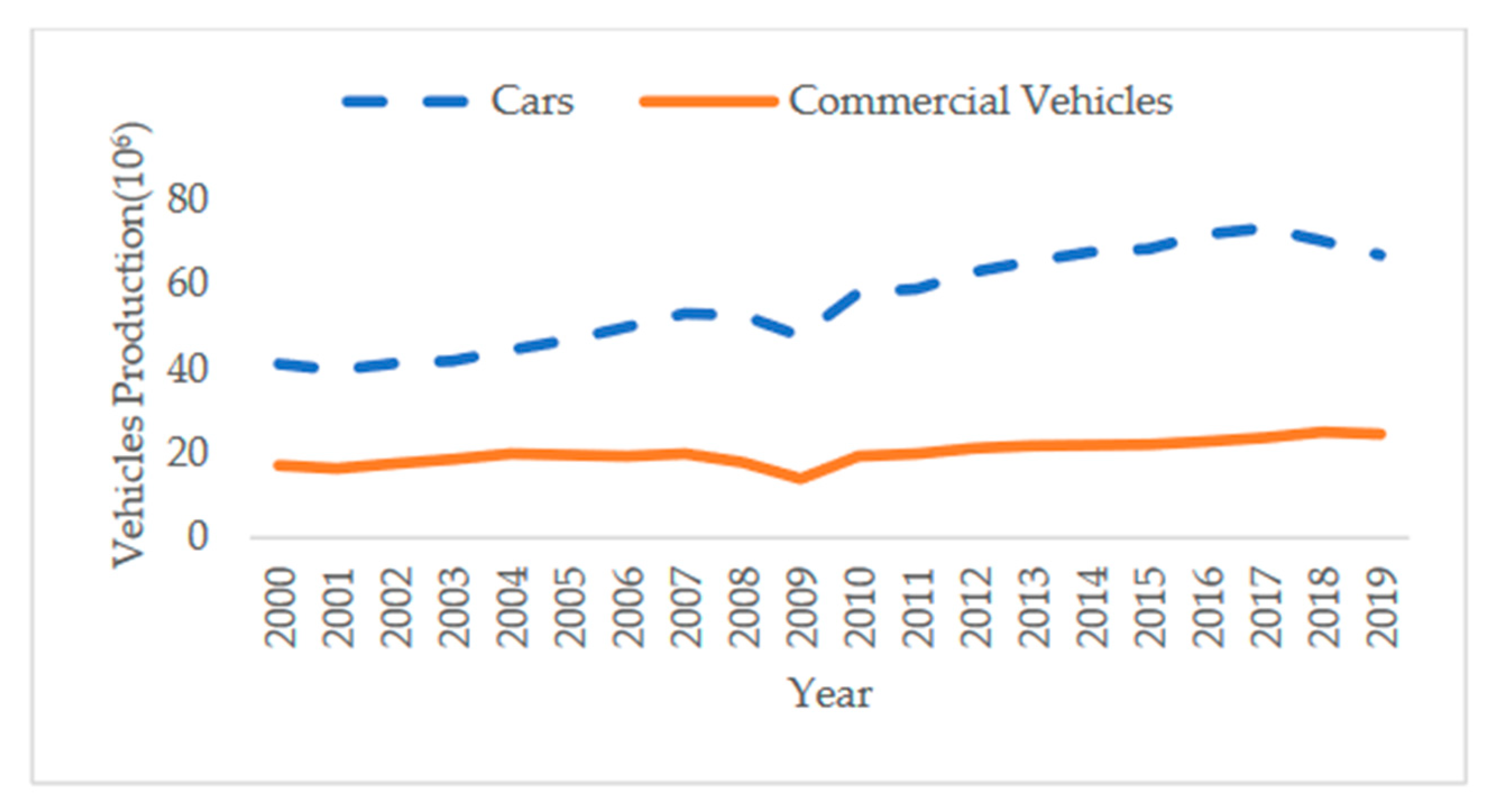


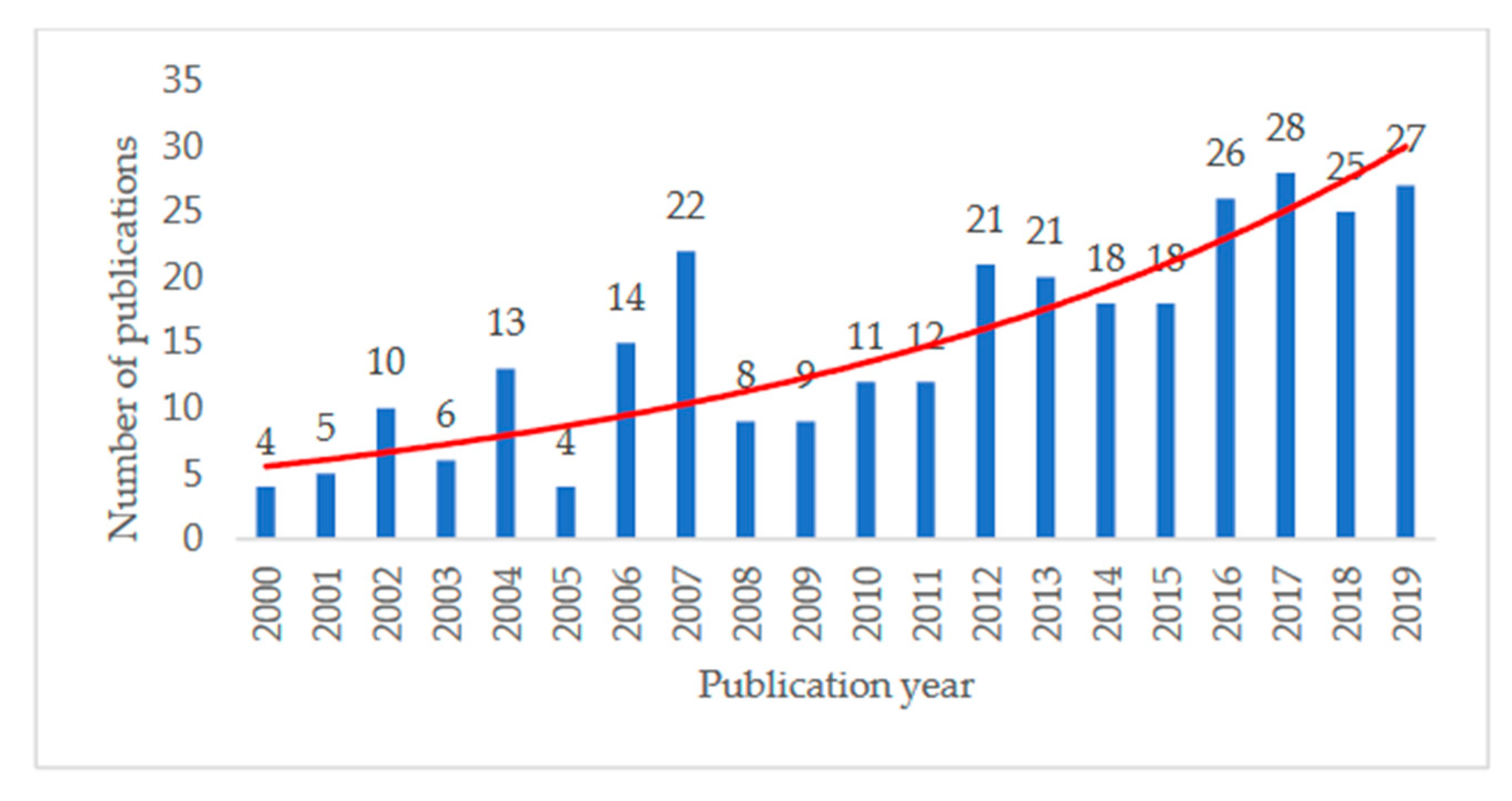
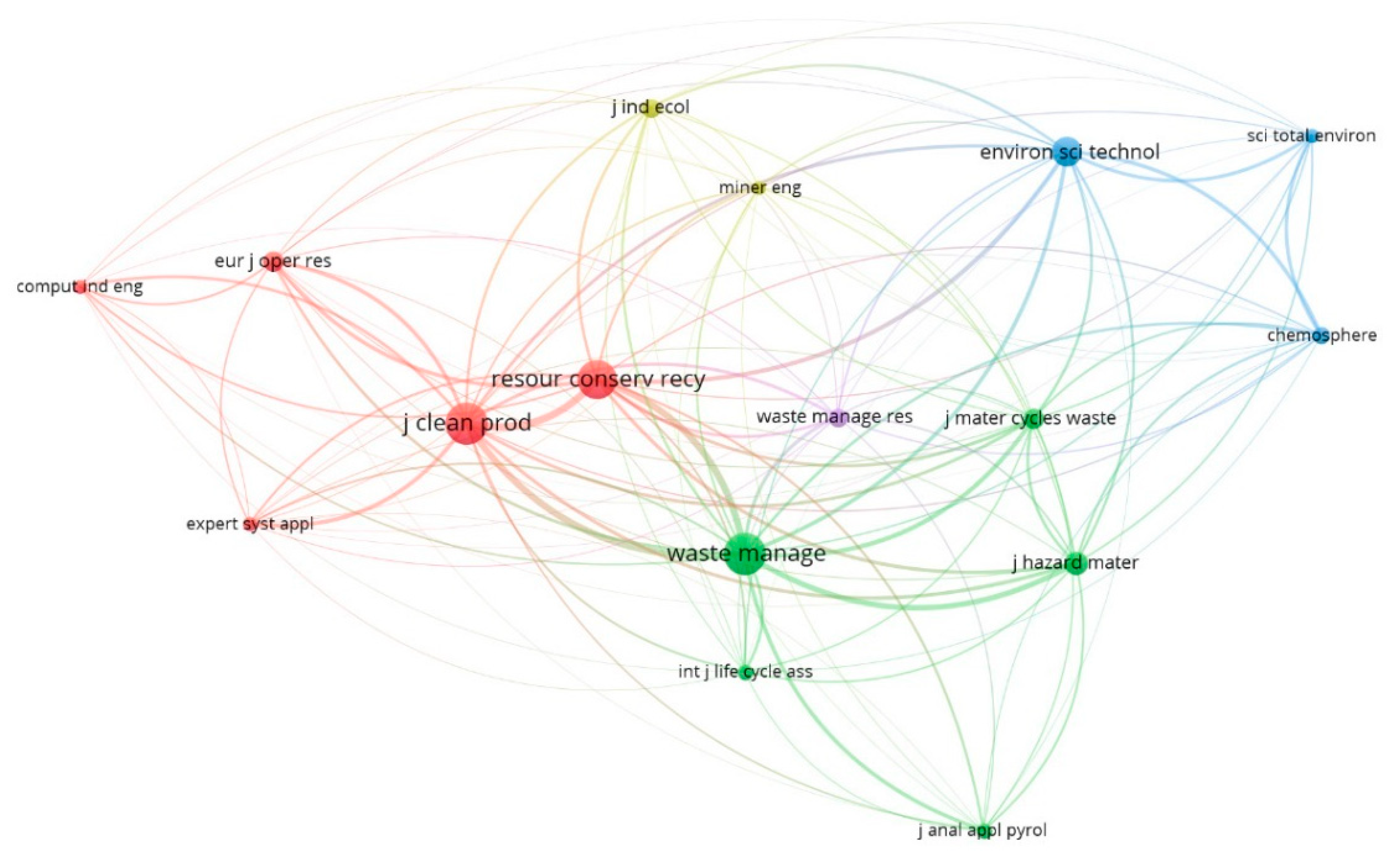

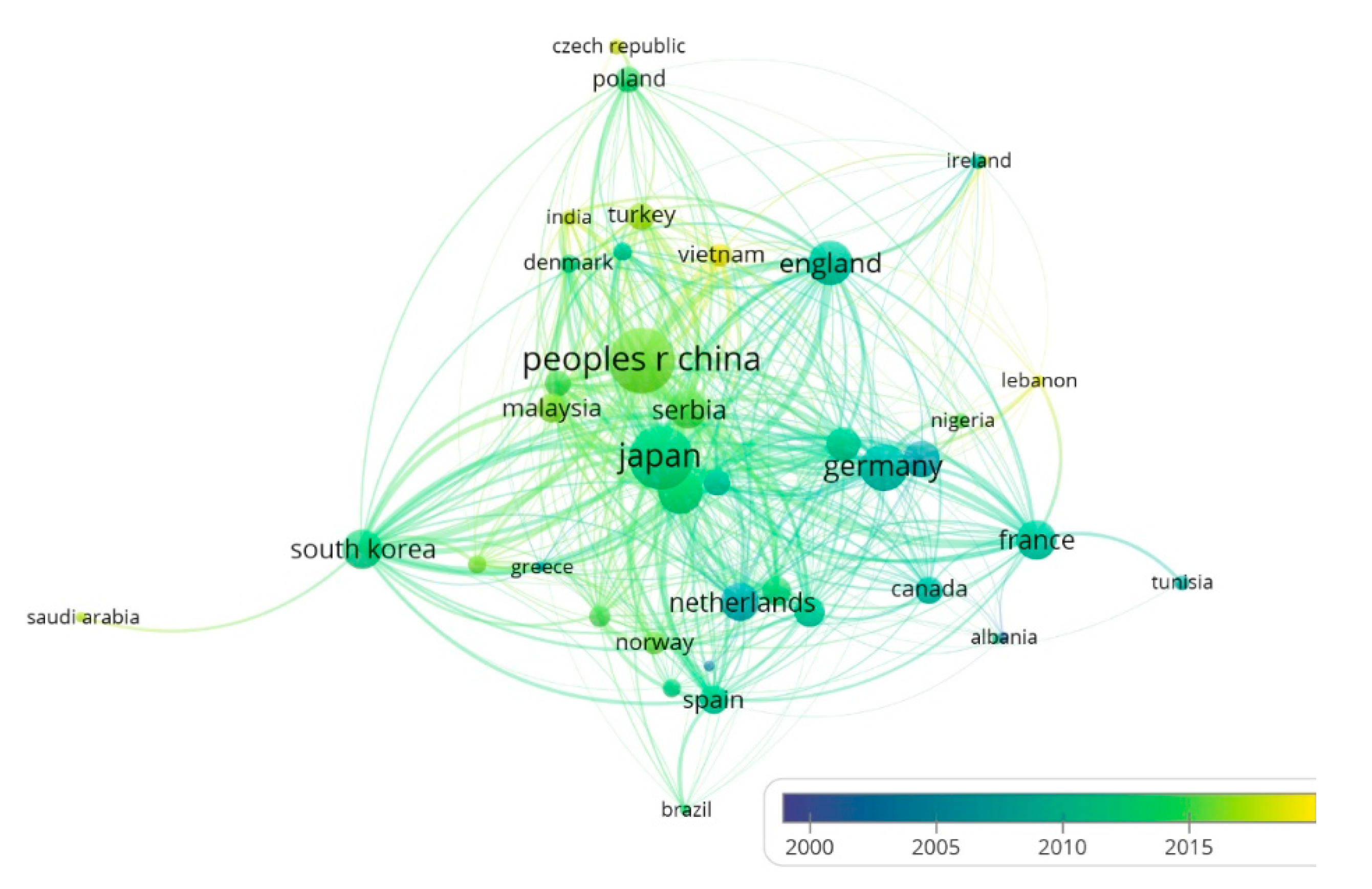

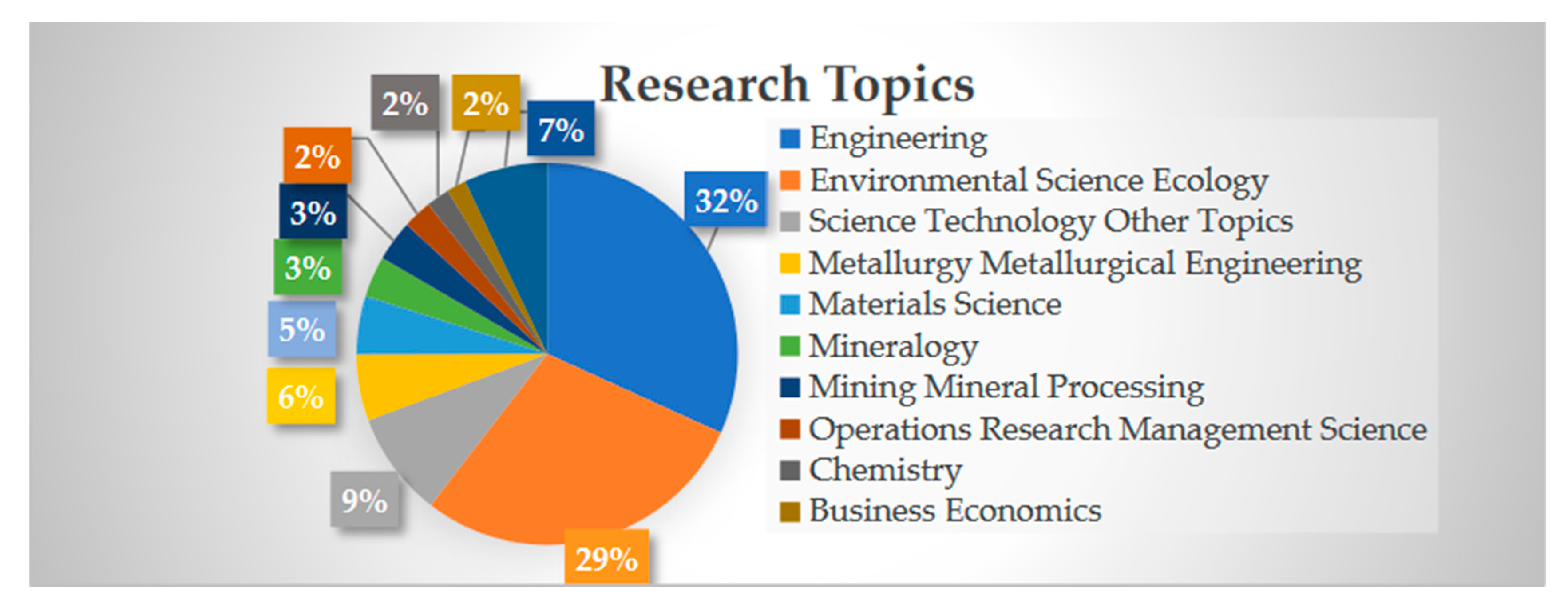

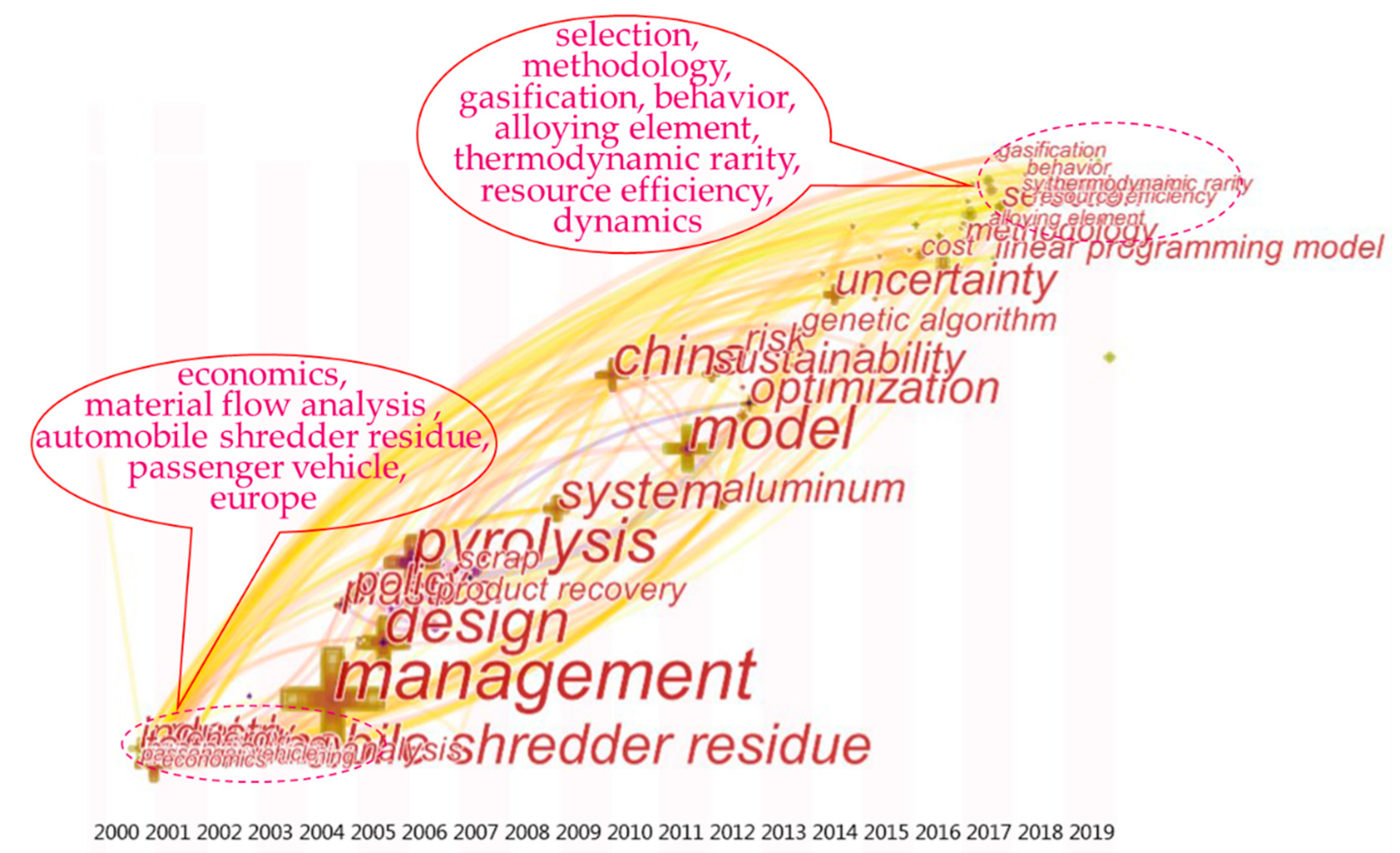
| Review Papers | Focus | Period | Number of Collected Literature |
|---|---|---|---|
| Sharma and Pandey [12] | ELVs processing | 2013–2019 | 41 |
| Karagoz et al. [13] | ELVs management | 2000–2019 | 232 |
| Rosa and Terzi [14] | ELVs waste streams | 2001–2015 | 35 |
| Cucchiella et al. [15] | Automotive electronics | 2000–2014 | 50 |
| Buekens and Zhou [16] | Automotive shredder residue plastics | 1977–2012 | 76 |
| Gan and He [17] | Reverse logistics | 2002–2013 | 38 |
| Zhang and Chen [18] | Automotive plastics | 1993–2012 | 63 |
| Simic [2] | Environmental engineering issues | 2003–2012 | 93 |
| Go et al. [19] | Disassemblability | 1992–2010 | 38 |
| Nourreddine [20] | Shredder residue treatment | 1991–2004 | 26 |
| TP | Percentage | Journal | TC | Impact Factor | H-Index |
|---|---|---|---|---|---|
| 34 | 11.565% | Journal of Cleaner Production | 855 | 7.246 | 19 |
| 32 | 10.884% | Waste Management | 642 | 5.448 | 15 |
| 25 | 8.503% | Resources Conservation and Recycling | 685 | 7.044 | 15 |
| 13 | 4.422% | Journal of Material Cycles and Waste Management | 150 | 1.974 | 8 |
| 13 | 4.422% | Waste Management Research | 124 | 2.771 | 8 |
| 12 | 4.082% | Jom | 188 | 2.029 | 8 |
| 11 | 3.741% | Environmental Science & Technology | 223 | 7.864 | 8 |
| 7 | 2.381% | Minerals Engineering | 243 | 3.795 | 7 |
| 6 | 2.041% | Journal of Industrial Ecology | 179 | 6.539 | 5 |
| 5 | 1.701% | Sustainability | 22 | 2.592 | 3 |
| Institution | Country | TP | H-Index | TC | CP | %TP |
|---|---|---|---|---|---|---|
| Shanghai Jiao Tong University | Peoples R China | 18 | 9 | 289 | 16.1 | 6.1 |
| University of Belgrade | Serbia | 14 | 10 | 209 | 14.9 | 4.8 |
| Tohoku University | Japan | 11 | 6 | 168 | 15.3 | 3.7 |
| National Institute for Environmental Studies—Japan | Japan | 11 | 5 | 159 | 14.5 | 3.7 |
| Delft University of Technology | Netherlands | 9 | 9 | 342 | 38 | 3.1 |
| Kyoto University | Japan | 9 | 4 | 90 | 10 | 3.1 |
| National Institute of Advanced Industrial Science Technology Aist | Japan | 8 | 6 | 100 | 12.5 | 2.7 |
| Yonsei University | South Korea | 7 | 6 | 138 | 19.7 | 2.4 |
| University of Tokyo | Japan | 7 | 4 | 61 | 8.7 | 2.4 |
| University of Bologna | Italy | 6 | 6 | 257 | 42.8 | 2.0 |
| Author | H-Index | Country | TP | TC | Institute |
|---|---|---|---|---|---|
| Chen, M | 8 | Peoples R China | 16 | 226 | Shanghai Jiao Tong University |
| Simic, V | 10 | Serbia | 13 | 208 | University of Belgrade |
| Reuter, MA | 8 | Australia | 8 | 310 | University of Melbourne |
| Seo, YC | 6 | South Korea | 8 | 162 | Yonsei University |
| Nakajima, K | 6 | Japan | 11 | 165 | University of Tokyo |
| Dimitrijevic, B | 6 | Serbia | 6 | 129 | University of Belgrade |
| Nakamura, S | 5 | Japan | 5 | 149 | Waseda University |
| Santini, A | 5 | Italy | 5 | 248 | University of Bologna |
| Passarini, F | 5 | Italy | 5 | 248 | University of Bologna |
| Matsubae, K | 5 | Japan | 8 | 155 | Tohoku University |
| Articles | Journal | TC |
|---|---|---|
| Schultmann et al. [34] | European Journal of Operational Research | 154 |
| Gerrard and Kandlikar [35] | Journal of Cleaner Production | 144 |
| Cruz-Rivera and Ertel [36] | European Journal of Operational Research | 101 |
| Zhang et al. [40] | Resources Conservation and Recycling | 100 |
| Michalek et al. [39] | Journal of Mechanical Design | 82 |
| Ferguson and Browne [37] | Production Planning & Control | 78 |
| Morselli et al. [42] | Waste Management | 74 |
| Ragaert et al. [41] | Waste Management | 72 |
| Nourreddine [20] | Journal of Hazardous Materials | 69 |
| Mazzanti and Zoboli [38] | Ecological Economics | 69 |
| References | Network Structure | Optimization Models | Single-Multi Objective | Type of Objective Functions | Type of Parameters | Solution Approach | |||||||||
|---|---|---|---|---|---|---|---|---|---|---|---|---|---|---|---|
| OLSC | CLSC | LP | MILP | MINLP | Single | Multi | Max | Min | Det. | Prob. | Fuzzy | E | H | MH | |
| Schultmann et al. [34] | √ | √ | √ | √ | √ | √ | |||||||||
| Mansour and Zarei [64] | √ | √ | √ | √ | √ | √ | |||||||||
| Cruz-Rivera and Ertel [36] | √ | √ | √ | √ | √ | √ | |||||||||
| Zarei et al. [59] | √ | √ | √ | √ | √ | √ | |||||||||
| Mahmoudzadeh et al. [65] | √ | √ | √ | √ | √ | √ | |||||||||
| Vidovic et al. [66] | √ | √ | √ | √ | √ | √ | |||||||||
| Farel et al. [67] | √ | √ | √ | √ | √ | √ | |||||||||
| Gołębiewski et al. [60] | √ | √ | √ | √ | √ | ||||||||||
| Mahmoudzadeh et al. [68] | √ | √ | √ | √ | √ | √ | |||||||||
| Simic [63] | √ | √ | √ | √ | √ | √ | √ | √ | |||||||
| Simic [69] | √ | √ | √ | √ | √ | √ | √ | √ | |||||||
| Simic [70] | √ | √ | √ | √ | √ | √ | √ | ||||||||
| Simic [71] | √ | √ | √ | √ | √ | √ | √ | ||||||||
| Simic [57] | √ | √ | √ | √ | √ | √ | √ | ||||||||
| Demirel et al. [72] | √ | √ | √ | √ | √ | √ | |||||||||
| Phuc et al. [61] | √ | √ | √ | √ | √ | √ | √ | ||||||||
| Özceylan et al. [55] | √ | √ | √ | √ | √ | √ | |||||||||
| Lin et al. [58] | √ | √ | √ | √ | √ | √ | |||||||||
| Shankar et al. [73] | √ | √ | √ | √ | √ | √ | |||||||||
| Sun et al. [74] | √ | √ | √ | √ | √ | √ | |||||||||
| Kuşakcı et al. [11] | √ | √ | √ | √ | √ | √ | √ | ||||||||
| Zhang et al. [62] | √ | √ | √ | √ | √ | √ | √ | ||||||||
| Xiao et al. [56] | √ | √ | √ | √ | √ | √ | |||||||||
Publisher’s Note: MDPI stays neutral with regard to jurisdictional claims in published maps and institutional affiliations. |
© 2020 by the authors. Licensee MDPI, Basel, Switzerland. This article is an open access article distributed under the terms and conditions of the Creative Commons Attribution (CC BY) license (http://creativecommons.org/licenses/by/4.0/).
Share and Cite
He, M.; Lin, T.; Wu, X.; Luo, J.; Peng, Y. A Systematic Literature Review of Reverse Logistics of End-of-Life Vehicles: Bibliometric Analysis and Research Trend. Energies 2020, 13, 5586. https://doi.org/10.3390/en13215586
He M, Lin T, Wu X, Luo J, Peng Y. A Systematic Literature Review of Reverse Logistics of End-of-Life Vehicles: Bibliometric Analysis and Research Trend. Energies. 2020; 13(21):5586. https://doi.org/10.3390/en13215586
Chicago/Turabian StyleHe, Meiling, Tianhe Lin, Xiaohui Wu, Jianqiang Luo, and Yongtao Peng. 2020. "A Systematic Literature Review of Reverse Logistics of End-of-Life Vehicles: Bibliometric Analysis and Research Trend" Energies 13, no. 21: 5586. https://doi.org/10.3390/en13215586






